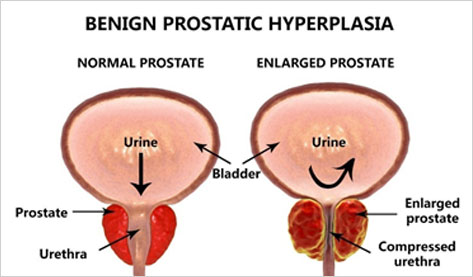
BPH stands for Benign Prostatic Hyperplasia. Benign means “not cancer,” and hyperplasia means too much growth. The result is that the prostate becomes enlarged. BPH is not linked to cancer and does not raise your chances of getting prostate cancer–yet the symptoms for BPH and prostate cancer can be similar.
BPH affects most men as they get older. It can lead to urinary problems like those with prostatitis. By age 60, many men have signs of BPH. By age 70, almost all men have some prostate enlargement. The prostate starts out about the size of a walnut. By the time a man is 40, it may have grown slightly larger, to the size of an apricot. By age 60, it may be the size of a lemon.
As a normal part of aging, the prostate enlarges and can press against the bladder and the urethra. This can slow down or block urine flow. Some men might find it hard to start a urine stream, even though they feel the need to go. Once the urine stream has started, it may be hard to stop. Other men may feel like they need to pass urine all the time or are awakened during sleep with the sudden need to pass urine.
Early BPH symptoms take many years to turn into bothersome problems. These early symptoms are a cue to see your doctor.
BPH symptoms usually start after the age of 50. They can include:
• Trouble starting a urine stream or making more than a dribble
• Passing urine often, especially at night
• Feeling that the bladder has not fully emptied
• A strong or sudden urge to pass urine
• Weak or slow urine stream
• Stopping and starting again several times while passing urine
• Pushing or straining to begin passing urine
If not treated timely and appropriately BPH can lead to:
• A weak bladder
• Backflow of urine causing bladder or kidney infections
• Complete block in the flow of urine
• Kidney failure
Treatment
About half the men with BPH eventually have symptoms that are bothersome enough to need treatment. BPH cannot be cured, but drugs or surgery can often relieve its symptoms. BPH symptoms do not always grow worse.
There are three ways to manage BPH:
• Watchful waiting (regular follow-up with your doctor)
• Drug therapy
• Surgery
Talk with your doctor about the best choice for you. Your symptoms may change over time, so be sure to tell your doctor about any new changes
Surgery for BPH is very patient friendly and is done through the urinary passage (urethra) with no external cut or drain. Commonest types being
TURP/BNI

HoLEP (Laser Prostate surgery)




